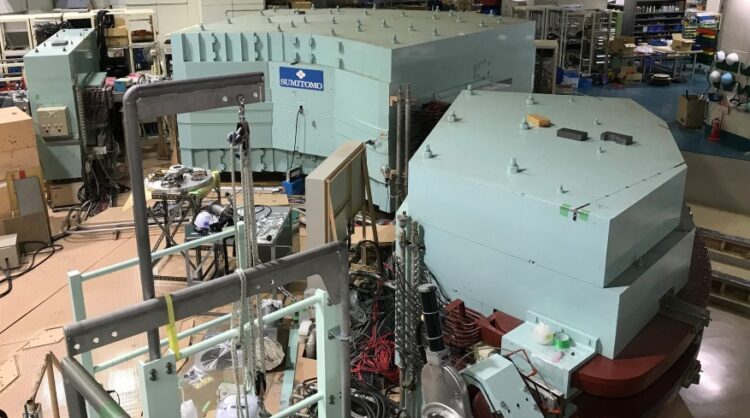Helium nuclei at the surface of heavy nuclei discovered

The experiments took place at the RCNP's GRAND RAIDEN spectrometer.
Picture: Thomas Aumann
Research team confirms a new nuclear property predicted by theory
Scientists are able to selectively knockout nucleons and preformed nuclear clusters from atomic nuclei using high-energy proton beams. In an experiment performed at the Research Center for Nuclear Physics (RCNP) in Osaka in Japan, the existence of preformed helium nuclei at the surface of several tin isotopes could be identified in a reaction. The results confirm a theory, which predicts the formation of helium clusters in low-density nuclear matter and at the surface of heavy nuclei. A research team, lead by scientists from TU Darmstadt and the GSI Helmholtz Center for Heavy-Ion Research, and from the RIKEN Nishina Center for Accelerator-Based Science, discuss the new findings in a contribution to the latest issue of the journal “Science”.
The strong interaction binds neutrons and protons together to atomic nuclei. The knowledge of properties of nuclei and their theoretical description is basis for our understanding of nuclear matter and the development of the universe. Laboratory-based studies of reactions between atomic nuclei provide means to explore nuclear properties. These experiments allow to test and verify theories that describe properties of extended nuclear matter at different conditions, as present, for instance, in neutron stars in the universe. Several theories predict the formation of nuclear clusters like helium nuclei in dilute nuclear matter. This effect is expected to occur at densities significantly lower than saturation density of nuclear matter, as present in the inner part of heavy nuclei. A theory developed in Darmstadt by Dr. Stefan Typel predicts that such a condensation of helium nuclei should also occur at the surface of heavy nuclei. Goal of the experiment, which is presented in the latest issue of “Science”, was the verification of this prediction.
The present experiment bombarded tin isotopes with high-energy protons and detected and identified the scattered protons as well as knocked-out helium nuclei. Dr. Junki Tanaka and Dr. Yang Zaihong could demonstrate that the reaction occurs as a direct “quasi-elastic” scattering of the protons off preformed helium nuclei in the surface of tin nuclei. The extracted cross sections for different tin isotopes reveal a decrease of the formation probability with the neutron excess of the nuclei, which impressively confirms the theoretical prediction. This new finding, which has far-reaching consequences for our understanding of nuclei and nuclear matter, will now be studied in more detail in experimental programs planned at RCNP, and in inverse kinematics at RIKEN and the new FAIR facility at GSI, where also unstable heavy neutron-rich nuclei are accessible.
About TU Darmstadt
The Technical University (TU) of Darmstadt is one of Germany’s leading technical universities. TU Darmstadt incorporates diverse science cultures to create its characteristic profile. The focus is set on engineering and natural sciences, which cooperate closely with outstanding humanities and social sciences. Three research fields shape the profile of TU Darmstadt: I+I (Information and Intelligence), E+E (Energy and Environment) sowie M+M (Matter and Materials). We dynamically develop our portfolio of research and teaching, innovation and transfer, in order to continue opening up important opportunities for the future of society. Our 312 professors, about 4,500 scientific and administrative employees and about 25,400 students devote their talents and best efforts to this goal. In the UNITE! network, which unites universities from seven European countries, the TU Darmstadt is promoting the idea of the European university. Together with Goethe University Frankfurt and Johannes Gutenberg University Mainz, TU Darmstadt has formed the strategic Rhine-Main Universities alliance.
MI-Nr. 03e/2021, Aumann/Typel/sip
Wissenschaftliche Ansprechpartner:
Prof. Dr. Thomas Aumann
Institut für Kernphysik der TU Darmstadt
Tel.: 06151/16-23530
E-Mail: taumann@ikp.tu-darmstadt.de
Originalpublikation:
„Formation of α clusters in dilute neutron-rich matter“,
https://science.sciencemag.org/content/371/6526/260
https://www.tu-darmstadt.de/universitaet/aktuelles_meldungen/einzelansicht_294016.en.jsp
Media Contact
All latest news from the category: Physics and Astronomy
This area deals with the fundamental laws and building blocks of nature and how they interact, the properties and the behavior of matter, and research into space and time and their structures.
innovations-report provides in-depth reports and articles on subjects such as astrophysics, laser technologies, nuclear, quantum, particle and solid-state physics, nanotechnologies, planetary research and findings (Mars, Venus) and developments related to the Hubble Telescope.
Newest articles

Innovative 3D printed scaffolds offer new hope for bone healing
Researchers at the Institute for Bioengineering of Catalonia have developed novel 3D printed PLA-CaP scaffolds that promote blood vessel formation, ensuring better healing and regeneration of bone tissue. Bone is…

The surprising role of gut infection in Alzheimer’s disease
ASU- and Banner Alzheimer’s Institute-led study implicates link between a common virus and the disease, which travels from the gut to the brain and may be a target for antiviral…

Molecular gardening: New enzymes discovered for protein modification pruning
How deubiquitinases USP53 and USP54 cleave long polyubiquitin chains and how the former is linked to liver disease in children. Deubiquitinases (DUBs) are enzymes used by cells to trim protein…


